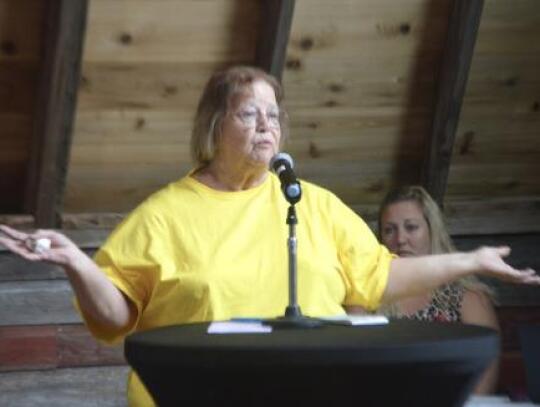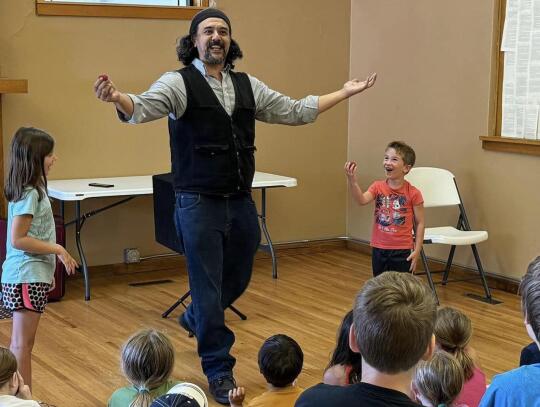CENTER – After hearing from a steady flow of people on opposite sides – including Wausa area residents – Knox County has tightened its zoning regulations in regard to wind energy.
In front of a crowd of nearly 100 people at The Barn at God’s Country north of Center, the county board of supervisors voted 5-1 July 24 in favor of five recommended amendments from the county planning commission on wind energy conversion systems.
The amendment that sparked the most comments between proponents and opponents of the proposed North Fork Wind Farm project during a public hearing was a 1.25-mile setback from the property line for wind turbines from dwelling units owned by non-participating landowners.
This change in the county’s zoning regulations will see the current setback of 2,000 feet increased to a 1.25-mile – 6,600-foot – barrier around any nonparticipating dwelling, reducing the number of new wind turbines that would go up in the county.
Representatives from National Grid Renewables, which is based in Bloomington, Minn., and recently opened a downtown Wausa office, have previously discussed the North Fork Wind Farm with the supervisors and the planning commission several times during the past year.
The project is proposed to be 600 megawatts in size and reportedly feature more than 100 wind turbines – a range of 130-150 has been mentioned – that each would measure between 600 and 650 feet tall, built in the eastern part of the county.
National Grid Renewables estimated the project would bring more than $230 million into the region through job creation, tax revenue, charitable donations and landowner income.
The public hearing on July 24 lasted for about two hours, with two 30-minute periods each for members of the public to speak – with three minutes per person – in favor of or against the recommended amendments to the county’s zoning regulations.
The supervisors then took 30 minutes to discuss the recommended amendments and comments they received before they made a decision.
Board Chairman Jim Sokol Jr., rural Verdigre, who represents District 4, said District 5 Supervisor Kevin Mackeprang, Bloomfield, has a lease for wind turbines on his property so he did not participate in the public hearing or when the board voted.
Sokol later became emotional as he told a story about how his parents benefited financially – after they lost land during the 1980s farm crisis – from having a roughly 900-foottall cell tower built on their property to help explain why he voted against the recommended amendments.
“I’m strongly wanting the wind towers for the people that are going to get revenue from them,” he said.
District 6 Supervisor Danny Schlote, rural Wausa, called the board’s decision “a tough one.”
“At first, I was in favor of keeping our amendments the same,” he said. “We had a planning commission meeting; nobody showed up.”
Schlote became emotional as he said he had several conversations with people about the North Fork Wind Farm as time went on, including his family members, who told him they did not want see wind turbines anywhere near their property, leading him to vote for the recommended amendments.
Mike Kumm, rural Wausa, was one of several people who spoke at a podium at the front of the large upstairs space at the events center in favor of the new setback distance.
“Three words that kind of guide zoning regulations are use, nuisance and safety,” he said. “They’re the three considerations that have to be taken into account when you look at the develop of property in this county.” Kumm, a member of a concerned group of citizens that has been referred to as the Knox County Wind Watchers and the Wausa Wind Watchers, said the rights of property owners are not absolute.
“We don’t have the absolute right to do anything we want,” he said. “We also don’t have the right to be absolutely free from any nuisance. So somewhere in-between those two absolutes, we have to find a balance, and that’s what the purpose of regulations are.”
Kumm and other members of the concerned citizens group previously proposed several amendments to the county’s zoning regulations during a county planning commission meeting early this year due to their concerns about the size of the North Fork Wind Farm’s individual wind turbines and the scope of the entire project at large.
“We brought forth 11 different proposed amendments,” he said. “With careful consideration, the planning commission arrived at the conclusion it would be simpler to address the issues all brought forth by one simple change to regulations by increasing the setback from a residence.”
Sean Lawler, senior manager of development with National Grid Renewables, referred to the 1.25-mile setback as a ban on wind farms in the county.
“This is a vote on regulations for Knox County,” he said. “This is not a vote on the North Fork Wind project. The regulations (if changed) would kill the North Fork Wind project. The 1.25-mile setback not only zones out wind farms, it also directly infringes on private property rights of Knox County farm families, property owners, taxpayers and citizens.”
Kumm said he would learn to live with any wind turbines that are built near his property if he has to.
“But at the same time, reasonable accommodations need to be made for the residents who live within the county,” he said. “As we go forth, it comes down to an issue of nuisance and safety. By allowing the setbacks to increase to 1.25 miles, we address the bulk of the concerns that have been brought forth.”
As far as he knew, Kumm said National Grid Renewables has not made any “material progress” toward completing its wind farm project. The company also had not applied for a conditional use permit as of July 29.
“It’s still in the planning phase,” he said. “Regardless of the amount of funds they have expended, it doesn’t change the fact that you’re (the supervisors) within your rights to set the regulations in a way that’s going to lead to the best balance between use, nuisance and safety.
“If you address those concerns and find a way for it to work altogether, National Grid is free to proceed with their project,” he said. “After all, the fact of the matter is, you could set the setbacks at 10 miles. It doesn’t mean you cannot develop wind energy in Knox County. All they have to have is a participating landowner and the setback issue becomes moot.”
Lawler said no factual or scientific evidence has been presented to justify why or how a setback greater than 2,000 feet would preserve the public health, safety and welfare of the communities that would be near the North Fork Wind Farm.
“If the argument is noise, Knox County already limits noise to 50 decibels in your existing regulations,” he said. “That 2,000foot setback – the sound level is anticipated to be less than 50 decibels. If the argument is shadow flicker, at 2,000 feet, no more than 30 hours of shadow flicker per year at a non-participating residence is expected.
“If the argument is safety, a 2,000-foot setback is approximately three times the height of typical modern wind turbines, which well exceeds the distance needed to protect residences from the unlikely scenario of a turbine collapse,” he said. “In addition, wind developers such as National Grid Renewables create detailed fire and emergency plans while also coordinating with local fire and emergency departments.”
In his opinion, Kumm said all National Grid Renewables is seeking to do through keeping the current setback at 2,000 feet is ensuring that it does not have to expend any further funds to acquire the ability to have its project built.
“Quite frankly, if they want it done – like a teenager who says, ‘If you don’t give me what I want, it’s going to ruin my life’ – the reality is, it’s not the end of wind energy in Knox County,” he said. “It just means they have a more difficult path forward, and one that might require them to expend additional funds. That doesn’t mean it’s a death knell.”
If people are concerned about visual impacts from wind turbines, Lawler said the state of Nebraska requires the structures to use aircraft detection lighting systems, which only trigger a flash of red light when an airplane is nearby.
“No justification has been given for visual impacts other than not liking the look of wind turbines,” he said. “This is subjective and not based on any factual evidence. There’s no need to revise Knox County’s already sufficiently stringent wind energy zoning regulations, which were just adopted by this board in November of last year. They already protect the health, safety and welfare of this community.”
Garnet Anderson, Wausa, was one of many meeting attendees who spoke in favor of the North Fork Wind Farm, noting while a tornado might tear through wind turbines that are built in the county or National Grid Renewables might go bankrupt, those events are not guaranteed to happen. “That’s maybes; maybes don’t count,” she said. “We’re dealing with facts here.”
Anderson pointed to the silhouette of a wind mill that is part of an image in the main front upper window of the events center that includes a barn and the words “God’s Country.” “That wind mill used to give power to that farm,” she said. “Look at the size of the tractors now. Look at the size of the planters. Look at the size of the farms. Everything is getting bigger. This is just part of it. You can’t say that somebody can have a huge hog confinement, but the next person can’t.”
In her opinion, Anderson said the North Fork Wind Farm would benefit not just the county, but everyone due to wind power being “clean energy.”
“That’s a real plus,” she said. “We need clean energy. And I do think that my rights as a land owner would be stepped on (if the recommended amendments pass). I should have the right if I want to build on my ground … just like so-and-so has a cattle feedlot. It’s just part of farming. We decide how we want to farm, and this is just part of it.”
Elizabeth Walvoord, a property owner and part-time resident who lives in the county about half of the year between Lindy and Santee, brought a model of a farm with a wind turbine built onto it that she said was built by a structural engineering professor at the University of Nebraska-Lincoln.
“This box is built to scale,” she said. “This is a one-acre scale. This is a 35-by-50-foot, single-story horse. This is a 50-by-120-foot machine shed. This 650-foot tower is to scale.”
Walvoord referred to the 2,000-foot setback for wine turbines from dwelling units owned by nonparticipating landowners.
“That means in Knox County, you could have one of these per quarter section, which means some participating and nonparticipating landowners could have up to 10 to 12 surrounding them at any given time,” she said.
With the number of wind turbines reportedly proposed at more than 100 for the North Fork Wind Farm, Walvoord said she favors a 1.25-mile setback instead of a 2,000-foot one.
“You’re talking about asking people to live in the middle of that many turbines,” she said. “It’s just inexcusable. Don’t let that be your legacy … as county supervisors.”
Matt Woolery, a developer with National Grid Renewables, wanted to clarify that the North Fork Wind Farm’s wind turbine heights would not exactly be double the size of older, similar structures located in the county.
“The reason these are getting taller, the technology’s growing consistently throughout the years,” he said, noting the height of the wind turbines from the base to the nose is staying relatively the same at about 315 feet tall, but “essentially what is happening is that the blade lengths are getting longer so you can capture more air in the same amount of space.
“You’re not increasing the number of towers; you’re actually reducing them because they would need to be spaced further apart,” he said. “In some of our models we’re looking at, these towers will be spaced up to a mile apart from north to south … so they’re not going to be on top of each other. The overall height differential, I believe, is less than 200 feet – 178 feet.”
Tamara Walter, who is one of the owners of land just outside of Crofton that has been in her family for more than 125 years, said she grew up in the Crofton area.
“To be honest, I would live nothing more than to come back and settle down with my growing family on the same farm that I grew up on,” she said.
Walter said she has traveled around the world and has seen lots of landscapes, but her favorite view will always be the sunset from her family farm.
“I have a spot right on the farm where, ironically, you can see the (current) windmills in the distance,” she said. “It’s my favorite spot. I took my boyfriend there. I take my kid there. It’s where we’re going to go have family dinners. It’s just how it is.”
Walter’s point was that she is in favor of the North Fork Wind Farm being built, as she does not mind having a view with wind turbines.
“This wind farm is not only going to bring extra income to the schools, towns, communities, it’ll help bring more people into Knox County,” she said. “This will help aid us in becoming a more strong place to call home.”
Walter said the supervisors should not approve the 1.25-mile setback and the county’s zoning regulations should remain unchanged.
“I would not only be disappointed if this proposed setback goes into effect, but hundreds of other landowners would be as well,” she said.









